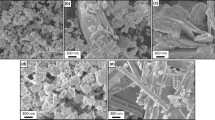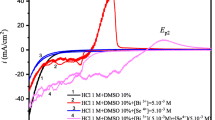Abstract
Bismuth oxychalcogenides such as Bi2O2Ch (Ch = S, Se, and Te) have attracted significant attention in the field of materials science because of their unique structure, chemical stability, and high carrier mobility, which make them potential candidates as novel functional materials for various applications. Recently, it was reported that an analogous material of Bi2O2Ch, bismuth oxycarbodiimide (Bi2O2NCN), can be synthesized and used in photoelectrodes. Bi2O2NCN contains the carbodiimide ion (NCN2−), which is a well-known pseudochalcogenide ion, instead of a chalcogenide ion. However, the preparation of metal (oxy)carbodiimides, including Bi2O2NCN, is limited to a few methods such as solid-phase metathesis. In this study, a simple liquid-phase preparation method for Bi2O2NCN was developed. Bi(NO3)3·5H2O, which was used as the Bi precursor, formed insoluble basic bismuth nitrate clusters when reacted with water under neutral pH conditions. Strong acidic conditions were required for the complete dissolution of these clusters. When the Bi precursor and H2NCN were homogeneously dissolved under strongly acidic conditions, and ammonia water was added, Bi2O2NCN was obtained with impurities. In contrast, when basic bismuth nitrate was undissolved, and ammonia water was added in the presence of H2NCN in an inhomogeneous system, basic bismuth nitrate clusters were rapidly converted to Bi2O2NCN with high crystallinity and purity. This method can be potentially applied to the preparation of various metal (oxy)carbodiimides by the liquid-phase process because of its simplicity, low cost, and low energy consumption.
Graphical Abstract

Highlights
-
Bismuth oxycarbodiimide was prepared using bismuth nitrate pentahydrate and cyanamide as precursors.
-
Bismuth oxycarbodiimide, which was obtained from a homogeneous solution in which the Bi precursor was completely dissolved, contained impurities.
-
In an inhomogeneous system that contained dispersions of insoluble basic bismuth nitrate clusters, bismuth oxycarbodiimide was rapidly obtained via basification in the presence of cyanamide.
-
The bismuth oxycarbodiimide prepared via an inhomogeneous liquid-phase process showed high purity and crystallinity.






Similar content being viewed by others
References
Wu J, Yuan H, Meng M, Chen C, Sun Y, Chen Z, Dang W, Tan C, Liu Y, Yin J, Zhou Y, Huang S, Xu HQ, Cui Y, Hwang HY, Liu Z, Chen Y, Yan B, Peng H (2017) High electron mobility and quantum oscillations in non-encapsulated ultrathin semiconducting Bi2O2Se. Nat Nanotechnol 12:530–534. https://doi.org/10.1038/nnano.2017.43
Wei Q, Lin C, Li Y, Zhang X, Zhang Q, Shen Q, Cheng Y, Huang W (2018) Physics of intrinsic point defects in bismuth oxychalcogenides: A first-principles investigation. J Appl Phys 124:055701. https://doi.org/10.1063/1.5040690
Tan C, Tang M, Wu J, Liu Y, Li T, Liang Y, Deng B, Tan Z, Tu T, Zhang Y, Liu C, Chen JH, Wang Y, Peng H (2019) Wafer-scale growth of single-crystal 2D semiconductor on perovskite oxides for high-performance transistors. Nano Lett 19:2148–2153. https://doi.org/10.1021/acs.nanolett.9b00381
Wu J, Liu Y, Tan Z, Tan C, Yin J, Li T, Tu T, Peng H (2017) Chemical patterning of high-mobility semiconducting 2D Bi2O2Se crystals for integrated optoelectronic devices. Adv Mater 29:1704060. https://doi.org/10.1002/adma.201704060
Luo P, Zhuge F, Wang F, Lian L, Liu K, Zhang J, Zhai T (2019) PbSe quantum dots sensitized high-mobility Bi2O2Se nanosheets for high-performance and broadband photodetection beyond 2 μm. ACS Nano 13:9028–9037. https://doi.org/10.1021/acsnano.9b03124
Tan C, Xu S, Tan Z, Sun L, Wu J, Li T, Peng H (2019) Exploitation of Bi2O2Se/graphene van der Waals heterojunction for creating efficient photodetectors and short-channel field-effect transistors. InfoMat 1:390–395. https://doi.org/10.1002/inf2.12025
Ruleova P, Drasar C, Lostak P, Li CP, Ballikaya S, Uher C (2010) Thermoelectric properties of Bi2O2Se. Mater Chem Phys 119:299–302. https://doi.org/10.1016/j.matchemphys.2009.08.067
Luu SDN, Vaqueiro P (2015) Synthesis, characterisation and thermoelectric properties of the oxytelluride Bi2O2Te. J Solid State Chem 226:219–223. https://doi.org/10.1016/j.jssc.2015.02.026
Tippireddy S, Kumar DSP, Das S, Mallik RC (2021) Oxychalcogenides as thermoelectric materials: an overview. ACS Appl Energy Mater 4:2022–2040. https://doi.org/10.1021/acsaem.0c02770
Wu M, Zeng XC (2017) Bismuth oxychalcogenides: a new class of ferroelectric/ferroelastic materials with ultra high mobility. Nano Lett 17:6309–6314. https://doi.org/10.1021/acs.nanolett.7b03020
Ghosh T, Samanta M, Vasdev A, Dolui K, Ghatak J, Das T, Sheet G, Biswas K (2019) Ultrathin free-standing nanosheets of Bi2O2Se: room temperature ferroelectricity in self-assembled charged layered heterostructure. Nano Lett 19:5703–5709. https://doi.org/10.1021/acs.nanolett.9b02312
Li MQ, Dang LY, Wang GG, Li F, Han M, Wu ZP, Li GZ, Liu Z, Han JC (2020) Bismuth oxychalcogenide nanosheet: facile synthesis, characterization, and photodetector application. Adv Mater Technol 5:2000180. https://doi.org/10.1002/admt.202000180
Li T, Peng H (2021) 2D Bi2O2Se: an emerging material platform for the next-generation electronic industry. Acc Mater Res 2:842–853. https://doi.org/10.1021/accountsmr.1c00130
Guo B, Guo Y, Xu L (2022) First-principles insight into the interfacial properties of epitaxial Bi2O2X (X = S, Se, Te) on SrTiO3 substrates. J Phys Chem Solids 163:110601. https://doi.org/10.1016/j.jpcs.2022.110601
Wang F, Yang S, Wu J, Hu X, Li Y, Li H, Liu X, Luo J, Zhai T (2021) Emerging two-dimensional bismuth oxychalcogenides for electronics and optoelectronics. InfoMat 3:1251–1271. https://doi.org/10.1002/inf2.12215
Zhang X, Liu Y, Zhang G, Wang Y, Zhang H, Huang F (2015) Thermal decomposition of bismuth oxysulfide from photoelectric Bi2O2S to Superconducting Bi4O4S3. ACS Appl Mater Interfaces 7:4442–4448. https://doi.org/10.1021/am5092159
Bondarenko EA, Streltsov EA, Mazanik AV, Kulak AI, Grivickas V, Ščajevc P, Skorb EV (2018) Bismuth oxysulfide film electrodes with giant incident photon-to-current conversion efficiency: the dynamics of properties with deposition time. Phys Chem Chem Phys 20:20340–20346. https://doi.org/10.1039/C8CP03225D
Bondarenko EA, Streltsov EA, Mazanik AV, Kulak AI (2019) Bismuth oxysulfide photoelectrodes with giant incident photon-to-current conversion efficiency: chemical stability in aqueous solutions. ChemElectroChem 6:2474–2481. https://doi.org/10.1002/celc.201900394
Kim SW, Masui T, Matsushita H, Imanaka N (2010) Enhancement in photoluminescence of Gd2O2CO3:Tb3+ submicron particles by introducing yttrium into the oxycarbonate lattice. J Electrochem Soc 157:J181–J185. https://doi.org/10.1149/1.3355985
Lian J, Qin H, Liang P, Liu F (2015) Co-precipitation synthesis of Y2O2SO4:Eu3+ nanophosphor and comparison of photoluminescence properties with Y2O3:Eu3+ and Y2O2S:Eu3+ nanophosphors. Solid State Sci 48:147–154. https://doi.org/10.1016/j.solidstatesciences.2015.08.004
Charkin DO, Akimov GA, Plokhikh IV, Zaloga AN, Borisov AS, Stefanovic SY, Kuznetsov AN, Siidra OI (2020) Bi2O2SO4, a new representative of the grandreefite structure type. J Solid State Chem 282:121124. https://doi.org/10.1016/j.jssc.2019.121124
Takeda T, Hatta N, Kikkawa S (2006) Gel nitridation preparation and luminescence property of Eu-doped RE2O2CN2 (RE = La and Gd) phosphors. Chem Lett 35:988–989. https://doi.org/10.1246/cl.2006.988
Ionescu E, Li W, Wiehl L, Mera G, Riedel (2017) Synthesis of nanocrystalline Gd2O2NCN from a versatile singles-source precursor. Z Anorg Allg Chem 643:1681–1691. https://doi.org/10.1002/zaac.201700266
Zhao W, Liu Y, Liu J, Chen P, Chen IW, Huang F, Lin J (2013) Controllable synthesis of silver cyanamide as a new semiconductor photocatalyst under visible-light irradiation. J Mater Chem A 1:7942–7948. https://doi.org/10.1039/C3TA10868F
Dolabdjian K, Castro C, Meyer HJ (2018) Layered carbodiimides A2M(CN2)3 with tetravalent cations M = Sn, Zr, and Hf. Eur J Inorg Chem 2018:1624–1630. https://doi.org/10.1002/ejic.201800183
Corkett AJ, Chen Z, Bogdanovski D, Slabon A, Dronskowski R (2019) Band gap tuning in bismuth oxide carbodiimide Bi2O2NCN. Inorg Chem 58:6467–6473. https://doi.org/10.1021/acs.inorgchem.9b00670
Chen Z, Corkett AJ, de Bruin-Dickason C, Chen J, Rokicińska A, Kuśtrowski P, Dronskowski R, Slabon A (2020) Tailoring the surface properties of Bi2O2NCN by in situ activation for augmented photoelectrochemical water oxidation on WO3 and CuWO4 heterojunction photoanodes. Inorg Chem 59:13589–13597. https://doi.org/10.1021/acs.inorgchem.0c01947
Okada R, Kawanishi K, Katagiri K, Inumaru K (2019) Ammonolysis-free synthesis of La2O2CN2 by cyanamidation of La(OH)3 using urea, and its photoluminescence properties. Ceram Int 45:9325–9329. https://doi.org/10.1016/j.ceramint.2019.01.262
Momma K, Izumi F (2011) VESTA 3 for three-dimensional visualization of crystal, volumetric and morphology data. J Appl Cryst 44:1272–1276. https://doi.org/10.1107/S0021889811038970
Kubelka P, Munk F (1931) Ein beitrag zur optik der farbanstriche. F Z Technol Phys 12:593–601
Tauc J (1968) Optical properties and electronic structure of amorphous Ge and Si. Mater Res Bull 3:37–46. https://doi.org/10.1016/0025-5408(68)90023-8
Nguyen VQ, Mahadadalkar MA, Rabie AM, Shim JJ (2022) Microwave-assisted synthesis of a Z-scheme heterojunction Ag/AgBr@BiOBr/Bi2O3 photocatalyst for efficient organic pollutant degradation under visible light. Environ Sci Nano 9:1724–1737. https://doi.org/10.1039/d1en01166a
Lazarini F (1981) Thermal dehydration of some basic bismuth nitrates. Thermochim Acta 46:53–55. https://doi.org/10.1016/0040-6031(81)85076-9
Miersch L, Rüffer T, Schlesinger M, Lang H, Mehring M (2012) Hydrolysis studies on bismuth nitrate: synthesis and crystallization of four novel polynuclear basic bismuth nitrate. Inorg Chem 2012:9376–9384. https://doi.org/10.1021/ic301148p
Karen VG, Hernández-Gordillo A, Oros-Ruiz S, Rodil SE (2021) Microparticles of α-Bi2O3 obtained from bismuth basic nitrate [Bi6O6(OH)2(NO3)4·2H2O] with photocatalytic properties. Top Catal 64:121–130. https://doi.org/10.1007/s11244-020-01299-8
Verma SK, Deb MK (2007) Nondestructive and rapid determination of nitrate in soil, dry deposits and aerosol samples using KBr-matrix with diffuse reflectance Fourier transform infrared spectroscopy (DRIFTS). Anal Chim Acta 582:382–389. https://doi.org/10.1016/j.aca.2006.09.020
Hou J, Yang C, Wang Z, Zhou W, Jiao S, Zhu H (2013) In situ synthesis of α–β phase heterojunction on Bi2O3 nanowires with exceptional visible-light photocatalytic performance. Appl Catal B 142–143:504–511. https://doi.org/10.1016/j.apcatb.2013.05.050
Gelderman K, Lee L, Donne SW (2007) Flat-band potential of a semiconductor: using the Mott–Schottky equation. J Chem Educ 84:685–688. https://doi.org/10.1021/ed084p685
Rathore E, Kundu K, Maji K, Das A, Biswas K (2021) Mixed-dimensional heterostructure of CsPbBr3 nanocrystal and Bi2O2Se nanosheet. J Phys Chem C 125:26951–26957. https://doi.org/10.1021/acs.jpcc.1c08319
Pacquette AL, Hagiwara H, Ishihara T, Gewirth AA (2014) Fabrication of an oxysulfide of bismuth Bi2O2S and its photocatalytic activity in a Bi2O2S/In2O3 composite. J Photochem Photobiol A 277:27–36. https://doi.org/10.1016/j.jphotochem.2013.12.007
Acknowledgements
This work was supported by JSPS KAKENHI (Grant Number JP22H05143). We would like to thank Editage (www.editage.com) for English language editing.
Funding
This study is funded by Japan Society for the Promotion of Science: KAKENHI, Grant Number: JP22H05143.
Author information
Authors and Affiliations
Corresponding author
Ethics declarations
Conflict of interests
The authors declare no competing interests.
Additional information
Publisher’s note Springer Nature remains neutral with regard to jurisdictional claims in published maps and institutional affiliations.
Supplementary information
Rights and permissions
Springer Nature or its licensor (e.g. a society or other partner) holds exclusive rights to this article under a publishing agreement with the author(s) or other rightsholder(s); author self-archiving of the accepted manuscript version of this article is solely governed by the terms of such publishing agreement and applicable law.
About this article
Cite this article
Sumioka, O., Tarutani, N., Katagiri, K. et al. Preparation of bismuth oxycarbodiimide Bi2O2NCN by a liquid-phase process. J Sol-Gel Sci Technol 108, 704–712 (2023). https://doi.org/10.1007/s10971-023-06175-x
Received:
Accepted:
Published:
Issue Date:
DOI: https://doi.org/10.1007/s10971-023-06175-x




